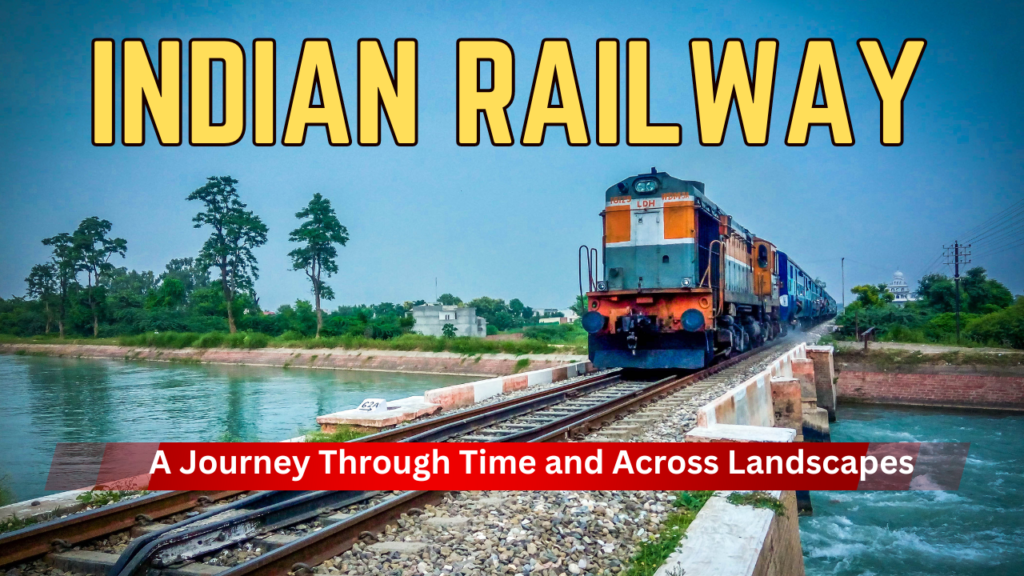Indian Railways, one of the largest railway networks in the world, serves as the lifeblood of the nation. It connects people across diverse cultures, languages, and landscapes, offering a glimpse into India’s rich heritage and modern aspirations. This guide explores the history, evolution, and scenic routes of Indian Railways, revealing its significance in shaping the nation.
1. A Historical Perspective
The Birth of Indian Railways
- Early Beginnings (1853): The first passenger train ran from Bombay (now Mumbai) to Thane on April 16, 1853, covering a distance of 34 kilometers. This marked the inception of rail transport in India.
- Colonial Expansion: The British colonial government expanded the railways to facilitate resource extraction and improve military logistics, connecting major cities and ports.
Post-Independence Developments
- Nationalization (1951): After India gained independence in 1947, the railway system was nationalized, laying the groundwork for extensive expansion and modernization.
- Technological Advancements: Over the decades, Indian Railways has embraced technology, introducing electric and diesel locomotives, high-speed trains, and digital ticketing.
2. The Structure of Indian Railways
A Massive Network
- Extent: Spanning over 68,000 kilometers, Indian Railways operates approximately 12,000 passenger trains daily, serving more than 23 million passengers.
- Zones and Divisions: The network is divided into 18 zones, each responsible for its own operations, maintenance, and development.
Classifications of Trains
- Passenger Trains: Including local trains, express trains, and luxury trains like the Palace on Wheels.
- Freight Trains: Vital for transporting goods, these trains carry everything from coal to agricultural produce across the country.
3. Scenic Routes: A Journey Through Landscapes
The Konkan Railway
- Overview: Stretching along the western coast of India, this route offers breathtaking views of the Arabian Sea, lush green hills, and charming villages.
- Highlights: The journey includes over 2,000 bridges and 90 tunnels, showcasing stunning vistas, particularly during the monsoon season.
The Himalayan Queen (Kalka-Shimla Railway)
- Heritage Status: A UNESCO World Heritage Site, this narrow-gauge railway travels through the picturesque Himalayan foothills.
- Experience: With over 100 tunnels and numerous bridges, it provides stunning views of deodar forests, valleys, and quaint hill stations.
The Palace on Wheels
- Luxury Experience: This opulent train offers a royal experience, traveling through Rajasthan’s majestic forts and palaces.
- Itinerary: Passengers enjoy guided tours of historic cities like Jaipur, Udaipur, and Jaisalmer while indulging in gourmet meals onboard.
The Darjeeling Himalayan Railway
- Iconic Route: Also a UNESCO World Heritage Site, this narrow-gauge railway connects New Jalpaiguri to Darjeeling.
- Scenery: Passengers are treated to stunning views of tea gardens, the majestic Kanchenjunga, and charming hill stations.
4. Cultural Significance
A Melting Pot of Cultures
- Diverse Passengers: The railways serve people from various backgrounds, showcasing India’s rich tapestry of languages, cuisines, and traditions.
- Cultural Exchange: Train journeys often serve as a platform for cultural interactions, with vendors selling local delicacies and passengers sharing stories.
Festivals and Celebrations
- Festive Travel: During major festivals like Diwali and Holi, Indian Railways experiences a surge in passengers, with special trains operating to accommodate the demand.
- Cultural Events: The railways also host various events onboard and at stations, celebrating local art, music, and dance.
5. Challenges and Innovations
Facing Challenges
- Infrastructure and Maintenance: With an ever-growing number of passengers, Indian Railways faces challenges related to overcrowding, aging infrastructure, and safety.
- Environmental Concerns: Balancing expansion with environmental sustainability is crucial, as the railways work towards reducing carbon emissions and promoting green initiatives.
Innovations and Future Prospects
- High-Speed Rail Projects: Initiatives like the Mumbai-Ahmedabad High-Speed Rail Corridor aim to transform train travel in India.
- Digital Initiatives: The introduction of mobile apps for ticket booking, real-time tracking, and enhanced customer service has modernized the travel experience.
Conclusion
Indian Railways is not just a mode of transportation; it’s a journey through time, connecting the past and present while traversing the stunning landscapes of India. As it continues to evolve, it remains a symbol of unity, diversity, and progress, making it an integral part of India’s identity. Whether you’re a local or a tourist, a train journey in India is an unforgettable experience that encapsulates the spirit of the nation.
Introduction to Indian Railways
Indian Railways, one of the largest railway networks in the world, has played a pivotal role in the historical and socio-economic development of India. Established in the mid-19th century, its operations commenced in 1853 with a modest stretch of track between Bombay (now Mumbai) and Thane. This ambitious project aimed to connect distant regions, facilitate trade, and enhance mobility for the population. Over the years, Indian Railways has transformed into an immense and intricate web of tracks, stations, and services that covers more than 67,000 kilometers, effectively linking the length and breadth of the nation.
Today, Indian Railways serves as the backbone of the Indian transportation system, providing effective and affordable transit options for millions. It operates over 22,000 trains daily, catering to diverse segments of the population, including commuters, tourists, and freight transporters. The network establishes important connections between urban and rural areas, thereby promoting economic integration and facilitating access to resources and employment opportunities. Furthermore, it plays a significant role in reducing traffic congestion and mitigating environmental impacts associated with road transport.
Beyond logistics, India’s railways hold cultural significance as well. The scenic train journeys through the diverse landscapes of India—from the picturesque hills of Himachal Pradesh to the expansive deserts of Rajasthan—offer travelers an immersive experience of the country’s rich heritage and natural beauty. Indian Railways, deeply ingrained in the fabric of the nation, continues to evolve, embracing modern technology and sustainability initiatives to enhance the passenger experience while addressing the needs of a growing population.
Historical Timeline of Indian Railways
The history of Indian Railways is a remarkable saga that has shaped not only transportation in India but also its economic and social landscape. The story began on April 16, 1853, when the first passenger train journeyed from Bombay to Thane, covering a distance of 34 kilometers. This momentous event marked the inception of the railway system in the subcontinent, fundamentally transforming how people and freight were transported.
As the years progressed, significant milestones were achieved. By 1869, the first railway line connecting Mumbai and Delhi was inaugurated, further enhancing trade and travel across northern and western India. The late 19th century witnessed rapid expansion as the railway networks extended to various parts of the country. In 1900, the total railway route length had reached around 18,000 kilometers, an impressive accomplishment reflecting the growing importance of railways in everyday life.
The early 20th century brought technological advancements, with the introduction of steam locomotives, which significantly improved operational efficiency. Following India’s independence in 1947, the railway network underwent nationalization, leading to increased investment in infrastructure and services. In the 1950s and 1960s, electrification began, paving the way for operational enhancements that improved speed and reduced pollution.
Fast forward to the 21st century, Indian Railways has embraced modernization and digitalization. The introduction of high-speed trains, smart ticketing systems, and Wi-Fi connectivity at stations signifies a new era. The launch of the semi-high-speed train, Vande Bharat Express, in 2019 symbolizes not just an upgrade to speed but also showcases India’s growing engineering capabilities.
Throughout this timeline, Indian Railways has navigated challenges and embraced opportunities, continually adapting to the evolving needs of the nation. Today, it stands as one of the largest railway networks in the world, serving millions of passengers daily and playing a crucial role in India’s economic growth.
Divisions and Geographical Spread
Indian Railways is a remarkable network that encompasses an extensive geographical expanse, divided into several zones, divisions, and routes. Spanning a large part of the Indian subcontinent, it connects remote regions and bustling cities alike, facilitating not just transport but also enhancing trade and tourism across the country. The railway network is divided into 18 zones, each comprising multiple divisions. These divisions enable the effective management and operations of trains, ensuring timely services and maintenance across varied terrains.
One of the most notable features of Indian Railways is the diverse landscapes it covers. From the snow-capped peaks of the Himalayas in the north to the lush green hills of the Western Ghats, and down to the sun-kissed beaches of the eastern coasts, the railway network traverses an array of environments. Key routes such as the Kalka-Shimla Railway offer breathtaking views of mountain ranges, while the Konkan Railway showcases the picturesque coastal scenery of the Arabian Sea. These varying environments not only provide stunning vistas but also offer travelers unique experiences associated with different regions of India.
The geographical spread of Indian Railways has played a crucial role in shaping the socio-economic landscape of the country. It has facilitated easier access to far-flung areas, promoting tourism by connecting users to destinations known for their historical, cultural, and natural significance. Verdicts such as the Nilgiri Mountain Railway or the Darjeeling Himalayan Railway have contributed to preserving heritage and drawing attention to scenic localities. Overall, the vastness and diversity of Indian Railways reflect and embody the rich tapestry of India’s geography, making it a vital component of the nation’s infrastructure.
The Cultural Significance of Train Journeys
Train journeys in India serve as more than mere transportation; they are a microcosm of the nation’s culture and heritage. Throughout history, Indian Railways has facilitated countless cultural exchanges, creating a unique space where diverse traditions intermingle. The passenger compartments become melting pots of various regional dialects, culinary specialties, and interpersonal interactions, allowing individuals from varied backgrounds to connect and share their stories.
Moreover, the food served during train journeys is often representative of the regional cuisine of the states traversed. Each journey introduces travelers to a plethora of local delicacies, from the spicy snacks of the North to the sweet treats of the South. Vendors boarding the trains serve freshly prepared regional dishes, thus ensuring that the culinary landscape of India is experienced at every stop. These food offerings transcend mere nourishment; they become a gateway to understanding the cultural fabric of each region.
Social interactions on trains further enrich the journey, facilitating exchanges that often lead to friendships and shared experiences. Travelers engage in lively conversations, swapping anecdotes and reflecting on their cultural traditions, thus celebrating the essence of Indian hospitality. Festivals, too, find their expression in train travel. Many people embark on journeys to participate in various local celebrations, treating the train ride itself as an integral part of the festivities.
The melodies and rhythms echoing through train compartments often reflect India’s rich musical heritage. Passengers might be treated to spontaneous performances, whether it be folk songs, classical music, or regional dances, allowing the art to flourish beyond the constraints of formal venues. In this way, train journeys contribute to the preservation and promotion of India’s cultural identity, making each trip an experience steeped in meaning and significance.
Modernization and Technological Advancements
The Indian Railways is currently undergoing a significant transformation, embracing modernization to enhance the travel experience and operational efficiency. This extensive modernization process includes the adoption of advanced technologies and the introduction of various digital services. One notable shift is the implementation of an integrated online ticketing system, which allows passengers to book, modify, and cancel their journeys through user-friendly applications and websites. This digital shift has not only simplified the ticketing process but has also enabled better management of resources and real-time updates for travelers.
In addition to digital services, Indian Railways is on the brink of a leap in speed and efficiency with the introduction of high-speed trains. Projects such as the Mumbai-Ahmedabad High-Speed Rail corridor exemplify this commitment to modernization, as they aim to cut travel time significantly while providing a comfortable ride. The integration of new technologies in these trains supports features such as improved safety, energy efficiency, and increased passenger capacity. Such innovations resonate with the growing demand for faster and more reliable transportation options, making train travel an appealing choice for many.
Sustainability has also become a core component of Indian Railways’ modernization efforts. The organization is increasingly investing in green technologies, such as solar energy and bio-toilets, to minimize its environmental footprint. Solar panels are being installed at various stations, harnessing renewable energy to power operations while reducing reliance on conventional electricity sources. Furthermore, the railways are actively promoting the use of electric locomotives, aiming to transition from fossil fuels to cleaner energy alternatives. These initiatives demonstrate a concerted effort to lead the way in sustainable transport, ensuring that modernization aligns with environmental responsibility.
Challenges Faced by Indian Railways
Indian Railways, one of the largest railway networks in the world, encounters numerous challenges that affect its efficiency and service quality. Foremost among these is the issue of aging infrastructure. Much of the rail network dates back several decades and is in dire need of modernization. Track deterioration, outdated signaling systems, and insufficient electrification present significant safety risks and operational inefficiencies. Consequently, maintaining safe and reliable service becomes an ongoing struggle amidst these infrastructural challenges.
Financial constraints further exacerbate the problems faced by Indian Railways. Although it plays a pivotal role in India’s economy by providing affordable transportation options, the entity grapples with the challenge of balancing operational costs with revenue generation. With rising fuel prices and the need for continued investment in upgrades, the financial sustainability of Indian Railways remains a pressing concern. The government has recognized this challenge and is exploring various avenues for public-private partnerships to enhance funding and investment flows.
Maintenance issues constitute another hurdle, with limited resources for routine upkeep leading to service delays and inconveniences. The need for a consistent maintenance schedule is crucial for sustaining the reliability of the railway system. Furthermore, the environmental impact of railway operations cannot be overlooked. With railway lands encroached upon and pollution from diesel locomotives, there is a growing demand for more sustainable practices and alternative energy sources. Initiatives promoting electrification and the use of renewable energy sources are being prioritized to mitigate these environmental concerns.
Despite these challenges, Indian Railways is actively taking steps to enhance overall service quality. Strategic investments in infrastructure development, technology adoption, and operational efficiency programs are underway. With continued focus and collaboration at various levels, there is potential for overcoming the long-standing challenges facing Indian Railways, ensuring it remains a vital component of India’s transport system.
Iconic Train Routes to Experience
India’s vast network of railways offers some of the most picturesque and iconic train routes in the world, inviting travelers to embark on remarkable journeys that promise breathtaking views and unforgettable experiences. The Darjeeling Himalayan Railway, often referred to as the “Toy Train,” is a prime example of this charm. Designed as a narrow gauge railway, it weaves through the stunning landscapes of the Eastern Himalayas. As the train chugs along the winding tracks, passengers can relish panoramic views of lush tea gardens and misty mountains, creating an emotional connection with the natural beauty that surrounds them. This UNESCO World Heritage site exemplifies the essence of India’s heritage and its scenic allure.
Another remarkable route is the Konkan Railway, which stretches along the western coastline of India. This journey is particularly captivating as it meanders through coastal plains, verdant hills, and magnificent rivers. The route features over 2,000 bridges and 90 tunnels, providing travelers with numerous opportunities to witness the country’s diverse landscapes. One of the most awe-inspiring segments of the Konkan Railway is the stretch between Ratnagiri and Mangalore, famed for its stunning views of the Arabian Sea. Riders are often enchanted by the lush greenery that envelops the tracks during the monsoon season, with cascading waterfalls adding to the idyllic scenery.
Moreover, the journey on the Palace on Wheels offers a royal experience, epitomizing luxury travel while traversing the heart of Rajasthan. Passengers are treated to an elegant ambiance reminiscent of India’s regal past, alongside magnificent sights ranging from opulent palaces to serene deserts. Each of these iconic train routes highlights the emotional significance of train travel in India, where the journey is as enriching as the destination. Together, they showcase the rich tapestry of Indian culture, tradition, and natural beauty, inviting travelers to explore and connect with the diverse landscapes of this incredible nation.
Passenger Experience: From Booking to Journey
The Indian Railways, one of the largest railway networks in the world, offers a unique travel experience characterized by its extensive reach and efficiency. The journey begins with the ticket booking process, which has undergone significant modernization. Passengers can choose to book tickets through various channels, including online platforms, mobile applications, and at the railway stations. The introduction of e-tickets has made the process more convenient, allowing passengers to secure their journeys from the comfort of their homes. Users can view seat availability, select preferred accommodations, and even make payments through a secure gateway.
Once the tickets are booked, passengers can explore a range of accommodations tailored to different budgets and needs. Indian Railways provides various classes, from luxurious air-conditioned coaches to more economical sleeper classes. Passengers often share their preferences and experiences, with many praising the comfort of first-class compartments yet appreciating the community atmosphere found in third-class seating. Each class comes with its unique ambiance, allowing travelers to choose based on their personal comfort or financial constraints.
The onboard services further elevate the passenger experience. Many trains offer catering options, with diverse menus reflecting the culinary richness of India. Passengers often recount their enjoyment of local snacks and meals during long journeys. Moreover, the availability of clean restrooms and regular announcements adds to the overall comfort. However, some travelers have noted occasional delays in service, emphasizing the importance of patience during the journey.
Traveling by Indian Railways is not just about reaching a destination but is an experience filled with cultural exchanges and interactions. Passengers share stories of newfound friendships or memorable incidents, enhancing the overall journey. With millions of travelers using this mode of transportation, the Indian Railways continues to evolve, striving to improve the passenger experience while cherishing the rich heritage of train travel in India.
The Future of Indian Railways
The future of Indian Railways appears promising, marked by ambitious projects and modernization efforts aimed at creating a more efficient and sustainable transportation system. As the backbone of the nation’s infrastructure, Indian Railways is not only crucial for connecting distant regions but also plays a significant role in economic development. The government has set forth several initiatives to enhance passenger experience, bolster safety, and reduce environmental impact.
One of the key areas of focus is the introduction of high-speed trains. Projects such as the Mumbai-Ahmedabad High-Speed Rail Corridor signify a shift towards faster, more reliable travel options that cater to the growing demands of the populace. These modern trains will not only reduce travel time but also serve as a catalyst for economic activity in the regions they connect, thereby enhancing accessibility for millions.
In addition to speed, Indian Railways is actively upgrading its existing infrastructure. Initiatives like the modernization of railway stations and the introduction of state-of-the-art services onboard are expected to significantly enhance the travel experience for passengers. Smart technology will be integrated into operations, making ticket booking, real-time tracking, and customer service more efficient than ever before. Moreover, plans to electrify the entire railway network by 2023 aim to reduce reliance on fossil fuels, leading to a greener and more sustainable mode of transport.
Furthermore, the emphasis on public-private partnerships is likely to bring in innovative solutions and investment, fostering greater efficiency within the system. As the vision for a modern Indian Railways unfolds, the commitment to environmental responsibility and social inclusivity will ensure that this critical mode of transportation continues to serve the vast Indian populace effectively. The transformational journey of Indian Railways is set to redefine rail travel in the years to come.












